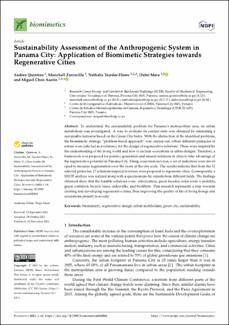| dc.contributor.author | Quintero, Andrea | |
| dc.contributor.author | Zarzavilla, Marichell | |
| dc.contributor.author | Tejedor-Flores, Nathalia | |
| dc.contributor.author | Mora, Dafni | |
| dc.contributor.author | Chen Austin, Miguel | |
| dc.date.accessioned | 2022-01-12T13:06:31Z | |
| dc.date.available | 2022-01-12T13:06:31Z | |
| dc.date.issued | 2021-11-16 | |
| dc.identifier.uri | https://ridda2.utp.ac.pa/handle/123456789/13482 | |
| dc.identifier.uri | https://doi.org/10.3390/biomimetics6040064 | |
| dc.description | To understand the sustainability problem for Panama’s metropolitan area, its urban metabolism was investigated. A way to evaluate its current state was obtained by estimating a sustainable indicator based on the Green City Index. With the abstraction of the identified problems, the biomimetic strategy “problem-based approach” was carried out, where different pinnacles of nature were selected as a reference for the design of regenerative solutions. These were inspired by the understanding of the living world and how to include ecosystems in urban designs. Therefore, a framework was proposed for positive generation and natural solutions in cities to take advantage of the regenerative potential in Panama City. Using ecosystem services, a set of indicators were developed to measure regeneration over the years at the city scale. The results indicate that from the 11 selected pinnacles, 17 solutions inspired in nature were proposed to regenerate cities. Consequently, a SWOT analysis was realized along with a questionnaire by experts from different fields. The findings obtained show that the feasible solutions were: arborization, green facades, solar roofs, e-mobility, green corridors, bicycle lanes, sidewalks, and biofilters. This research represents a step towards creating and developing regenerative cities, thus improving the quality of life of living beings and ecosystems present in society. | en_US |
| dc.description.abstract | To understand the sustainability problem for Panama’s metropolitan area, its urban metabolism was investigated. A way to evaluate its current state was obtained by estimating a sustainable indicator based on the Green City Index. With the abstraction of the identified problems, the biomimetic strategy “problem-based approach” was carried out, where different pinnacles of nature were selected as a reference for the design of regenerative solutions. These were inspired by the understanding of the living world and how to include ecosystems in urban designs. Therefore, a framework was proposed for positive generation and natural solutions in cities to take advantage of the regenerative potential in Panama City. Using ecosystem services, a set of indicators were developed to measure regeneration over the years at the city scale. The results indicate that from the 11 selected pinnacles, 17 solutions inspired in nature were proposed to regenerate cities. Consequently, a SWOT analysis was realized along with a questionnaire by experts from different fields. The findings obtained show that the feasible solutions were: arborization, green facades, solar roofs, e-mobility, green corridors, bicycle lanes, sidewalks, and biofilters. This research represents a step towards creating and developing regenerative cities, thus improving the quality of life of living beings and ecosystems present in society. | en_US |
| dc.format | application/pdf | en_US |
| dc.language.iso | eng | en_US |
| dc.publisher | MDPI | en_US |
| dc.rights | info:eu-repo/semantics/openAccess | en_US |
| dc.rights | https://creativecommons.org/licenses/by-nc-sa/4.0 | en_US |
| dc.subject | biomimicry | en_US |
| dc.subject | regenerative design | en_US |
| dc.subject | urban metabolism | en_US |
| dc.subject | green city | en_US |
| dc.subject | sustainability | en_US |
| dc.title | Sustainability Assessment of the Anthropogenic System in Panama City: Application of Biomimetic Strategies towards Regenerative Cities | en_US |
| dc.type | info:eu-repo/semantics/article | en_US |
| dc.type | info:eu-repo/semantics/publishedVersion | en_US |
